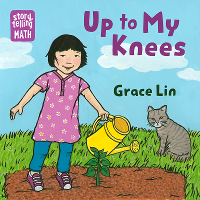New Picture Book Series Aims to Broaden Readers’ Views of Math and Diversity
Picture books are a powerful medium for helping children make sense of the world around them. Yet, when it comes to making sense of early math concepts, many picture books prioritize math over story, and few feature main characters of color.

New Picture Book Series Aims to Broaden Readers’ Views of Math and Diversity
Picture books are a powerful medium for helping children make sense of the world around them, according to Alyssa Mito Pusey, executive editor at Charlesbridge Publishing. Yet, when it comes to making sense of early math concepts, “many picture books prioritize math over story,” she observes, “and few feature main characters of color.”
Charlesbridge is releasing a new picture book series that aims to change that. The series, called Storytelling Math, is intended to broaden readers’ notions of what math picture books can be — while  expanding their views of math and who can do it.
expanding their views of math and who can do it.
The idea for the series began when the Heising Simons Foundation approached Marlene Kliman, a senior scientist at TERC, about developing a new paradigm for math picture books that reflects the nation’s diversity and aligns with current research.
“When we looked around at math picture books in print, we saw a lot of animal and white characters and concept books,” Kliman explains. “And the math tended to focus on counting and shapes, just two of the many math topics important for young children.”
Kliman, who served as a math advisor for the series, turned to Charlesbridge to produce the books because of the company’s longstanding commitment to diversity and its prior work in math fiction. Together, they scoped out a vision for the Storytelling Math series with three key goals in mind:
- To introduce children to important but often overlooked math topics. “There are lots of wonderful shapes and counting books out there, but kids need exposure to a richer array of math topics, such as patterns, categorizing, and spatial reasoning,” Kliman says. “Research has shown that facility with math topics like these is critically important for young children’s school success in all subjects, including reading.”
- To increase diversity in children’s math books. “Kids need books that reflect the diversity of our world,” Pusey notes. “Books featuring characters of color can give all readers a more inclusive vision of who can do math. What’s more, diverse books can empower young readers, validate their experiences, and make them feel seen.”
- To make math more visible and accessible. “Each story highlights and celebrates math that children genuinely use in their everyday lives — things like comparing two amounts to see who has more, seeing who’s taller, finding a container just the right size, and figuring out what to do when you’re making a bead pattern and you run out of one of the colors,” Kliman says. “Because the stories are grounded in the familiar, they demystify math and make it accessible and friendly.”
Each book includes a section called “Exploring the Math” at the end, with simple, hands-on activities for  kids and grown-ups to explore math together. “Hopefully, reading these books will encourage children and their parents to talk about math and look for it in their everyday life,” Pusey says. “Conversations like these can help children become stronger, more confident mathematical thinkers.”
kids and grown-ups to explore math together. “Hopefully, reading these books will encourage children and their parents to talk about math and look for it in their everyday life,” Pusey says. “Conversations like these can help children become stronger, more confident mathematical thinkers.”
Award-winning children’s author Grace Lin wrote and illustrated four of the 12 books in the series.
“When my child was a baby, I was frustrated at the lack of diverse baby board books,” she says. “There were very few books that showed a mother who looked like me or a baby who looked like my daughter.” So when Pusey invited her to contribute board books to the Storytelling Math series, Lin happily agreed.
In coming up with ideas for the books, Lin used the four seasons as a guide. “I thought about what my daughter and her friends do during each season and how it related to various math concepts,” she says. “In the spring, we plant gardens and measure how the plants grow. In the summer, we blow bubbles from flat circles. In the fall, we visit farmer’s markets and pick vegetables that fit our basket. And in the winter, we share marshmallows for our hot cocoa.”
The Storytelling Math concept appealed to Lin, because its purpose is to show readers that math “is commonplace and everywhere, and not something unusual or alien,” she says. “These are all everyday, typical experiences. Yet there is a magical joy to them — and math is a part of that magic. The joy of blowing bubbles with friends, how a round sphere comes out of a triangular wand — these are marvelous things to treasure.”
This joy in the everyday use of math is what Pusey and Kliman hope the series will impart.
“We expect good picture books to be emotionally resonant and compelling,” they conclude. “Why not expect the same of math picture books? In math, as in all subjects, children need engaging stories that they’ll want to read again and again — gaining new insights and joy on each rereading.”
SPONSORED CONTENT

RELATED
The job outlook in 2030: Librarians will be in demand
The job outlook in 2030: Librarians will be in demand
ALREADY A SUBSCRIBER? LOG IN
We are currently offering this content for free. Sign up now to activate your personal profile, where you can save articles for future viewing






Add Comment :-
Be the first reader to comment.
Comment Policy:
Comment should not be empty !!!